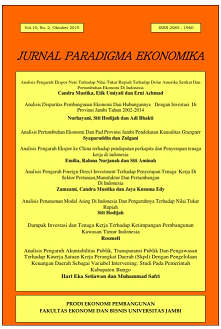Kualitas sumberdaya manusia dan sifat kewirausahaan pelaku industri kreatif usaha mikro kecil dan menengah di Kota Jambi
DOI:
https://doi.org/10.22437/paradigma.v12i2.4197Kata Kunci:
Risk, Innovative, Prestative, Instrumental, Independent, Social FlexibilityAbstrak
This study aims to analyze: 1) the quality of human resources in the creative industries of MSMEs in Jambi City; 2) entrepreneurial nature of MSMEs creative industry entrepreneurs in Jambi City. The data used is sourced from a sample survey limited to the MSMEs creative industry in Jambi City. The analysis was carried out in a qualitative and quantitative descriptive manner. The results of the study found that: 1) The age of entrepreneurs and creative industry workers MSMEs in Jambi City was relatively young and in the productive age group. Creative industry entrepreneurs are more male-dominated but for workers who are relatively balanced between men and women. In terms of formal education it is also relatively good, but in terms of informal education such as participation in training / courses / internships are still relatively low; 2) Overall, the entrepreneurial nature of MSMEs creative industry entrepreneurs in Jambi City is categorized as good. There are five entrepreneurial traits with excellent categories, namely the nature of risk taking, the nature of hard work, innovative nature, prestige and instrumental nature. Two other traits are included in the good category, namely independence and the flexibility of socializing.
Unduhan
Referensi
Departemen Perdagangan Republik Indonesia 2008, ‘Pengembangan Ekonomi Kreatif Indonesia 2025’, Rencana Pengembangan Ekonomi Kreatif Indonesia 2009-2015, DPRI, Jakarta.
Dian, Indri Purnamasari. 2004. Analisis Faktor-faktor yang Mempengaruhi Keefektifan Pengembangan Sistem Informasi. Jurnal Widya Manajemen dan Akuntansi, Vol. 4 No. 2 Agustus : 218-235
Fakih, Mansour. 2002. Runtuhnya Teori Pembangunan dan Globalisasi. Yogyakarta: Pustaka Pelajar dan Insist Press.
Glipo, Arze. 2002. Ketahanan Pangan. Dalam Harian Kompas Edisi 5 Juni 2002.
Hartono. 2001. Pengembangan Sumber Daya Manusia Untuk Pengelolaan Sumber Daya Alam. Makalah Seminar IMAHAGI. 27-30 September 2001 Bandar Lampung.
Howkins, J. (2005). Asia-Pacific Creative Communities: A Strategy for the 21st Century Senior Expert. Symposium, Jodhpur, India, 22-26 February 2005.
Lin, C.Y. (1998), “Success Factors of Small-andMedium-Sized Entreprises in Taiwan : An Analysis of Casesâ€, Journal of Small Business Management, Vol. 36, No,4, pp. 43-65
Martin, W.E., Brown, V.C., DeHayes, D.W., Hoffer, J.A., Perkins, W.C. 2002. Managing Information Technology. 4th Edition, Prentice Hall Publishing Company, New York
Meredith, GG. Nelson, RE. Neck, PA. 2005. Kewirausahaan Teori dan Praktek. Asparsayogi Andre, penerjemah; Jakarta: PPM. Terjemahan dari: The Practice of Entrepreneurship.
Moelyono, M. (2010). Menggerakkan Ekonomu Kreatif Antara Tuntutan dan Kebutuhan Cetakan ke 1. Jakarta: PT Raja Grafindo Persada
Nenny, A. 2008. “Industri Kreatifâ€, Jurnal ekonomi Desember 2008 Volume XIII No. 3 hal. 144-151.
Nugroho, Puguh Setyo, 2008.â€Analis Industri Kreatifâ€, Jurnal Ekonomi Desember 2008
Olomi, D.R. (1999b), “Scope and Role of Research on Entrepreneurship and Small Business Developmentâ€, in African Entreupreneurship and Small Business Development, Ed. Rutashobya, L.K. and Olomi, D.R., DUP(1996) LTD : Dar es Salaam, pp. 53-63
Riyanti, BPD. 2003. Kewirausahaan dari Sudut Pandang Psikologi Kepribadian. Jakarta: Gramedia Widiasarana Indonesia.
Simatupang TM 2008, ‘Perkembangan Industri Kreatif’, Sekolah Bisnis dan Manajemen Institut Teknologi Bandung, hlm. 1-9.
Simatupang TM, Yudoko G, Handayati Y, Pascasuseno A, Permadi K & Listiani W 2008, ‘Analisis Kebijakan Pengembangan Industri Kreatif di Kota Bandung’, Jurnal Manajemen Teknologi, vol. 8, no. 1, hlm.1-23.
Sigit, Hananto. 1989. Transformasi Tenaga Kerja Selama Pelita. Prisma No. 5
Soedjatmoko. 1986. Dimensi Manusia Dalam Pembangunan. Jakarta: Penerbit LP3ES.
Soetrisno dan Mary Johnston. 1982. Pengembangan Masyarakat. Surakarta: Penerbit YIS.
Sumaatmadja, Nursid. 1989. Geografi Pembangunan. Jakarta: Penerbit P2LPTK.
Suryana. 2003. Kewirausahaan: Pedoman praktis, kiat dan proses menuju sukses.. Ed ke-1. Jakarta: Salemba Empat.
Yacob, T., 1987. Manusia, Ilmu, dan Teknologi Pergumulan Abadi Dalam Perang dan Damai. Yogyakarta: Penerbit Tiara Wacana
Yosa, E. 2009. Hubungan Kompetensi Pengrajin dengan Kinerja Industri Tempe: Kasus Usaha Kecil Anggota KOPTI Kabupaten Cianjur. Tesis pada Sekolah Pascasarjana Institut Pertanian Bogor.
Tambunan, T. (2005), “Promoting Small and Medium Enterprises with a Clustering Approach: A Policy Experience from Indonesiaâ€, Journal of Small Business Management, Vol 43 No. 2, pp.138-154.
Werner, Jon M., dan DeSimone, Randy L., 2009, Human Resources Development, 5th Edition, South-Western Cengage Learning, Mason
Westhead, P. And Cowling, M. (1995), “Employment Change in Independent OwnerManaged High-Technology Firms in Great Britainâ€, Small Business Economics, Vol 7, No. 2, pp.111-140
##submission.downloads##
Diterbitkan
Versi
- 2017-09-19 (1)
- 2017-09-19 (1)









